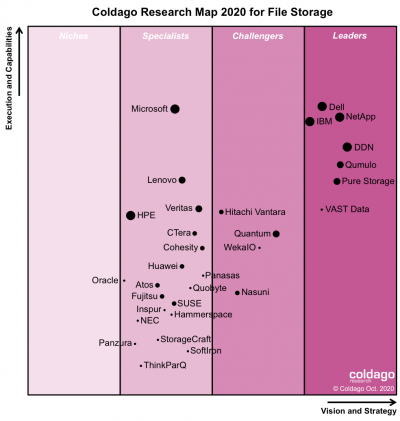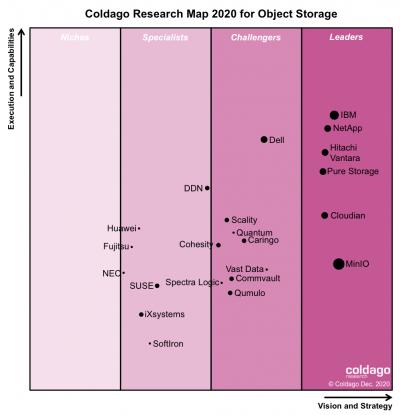Pure Storage FlashBlade Nears $1 Billion in Sales Since 5 Years
Could generate around $500 million for FY22.
This is a Press Release edited by StorageNewsletter.com on March 29, 2021 at 2:33 pmPure Storage, Inc. announced growth milestones to mark the 5 year anniversary of introducing FlashBlade.

Unveiled in March 2016, it has delivered Y/Y growth every quarter since. Within two years of general availability (GA), it reached a $250 million run rate and more than tripled its customer count. It continues to expand and diversify its customer base at a breakneck speed, adding several hundred new FlashBlade customers in FY21 and reaching nearly $1 billion in sales 4 years after GA. Today, more than 25% of the Fortune 100 use the AFA to derive value from their unstructured data.
The growth of the product has been powered by continuous innovation to solve for customer’s current needs, and also to enable them to take advantage of the next wave of modern data and applications to fuel their business.
The innovation FlashBlade has delivered includes:
- Platform evolution to power next generation workloads: It was built with dense scale-out capacity and multi-dimensional performance in mind and has been bolstered by feature upgrades, like native SMB support, SafeMode snapshots for ransomware protection, and software enhancements designed for real-time analytics, for example. In 2020, the device defined a new category of storage: Unified Fast File and Object (UFFO). By unifying fast file and fast object capabilities on a single platform, it empowers customers with future-proofed infrastructure for the rise of unstructured data.
- Partnerships and integrated solutions: To tackle a diverse set of customer challenges, FlashBlade has brought differentiated partnerships to bear. With NVIDIA, it created an integrated AI-Ready Infrastructure (AIRI), a joint solution for deploying deep learning at scale. With Cohesity, it created FlashRecover, Powered by Cohesity, a jointly-engineered all-flash data protection solution for rapid recovery, ransomware protection, and reuse of data. FlashBlade extended its unified fast file and object platform to AWS Outposts, enabling enterprises with a hybrid cloud solution to consolidate current and next-generation workloads.
- Flexible consumption models and non-disruptive upgrades: Pure’s Evergreen subscription to innovation lets FlashBlade customers adopt new features without disruption, downtime, or the requirement to re-buy capacity. With the option of buying FlashBlade’s Unified Fast File and Object Service through Pure as-a-Service, customers can select from Premium and Ultra Performance tiers to support traditional file and cloud object workloads, and also a variety of AI and ML, high performance compute, and software development needs, all delivered with pay as you go consumption.
“FlashBlade performance has been fantastic, with no downtime. With Vertica on Pure Storage, we have a 360° view of customers and fast, sophisticated analytics to provide all sorts of insights to the business, fueling customer success. Our users don’t know about the new technology underneath, they just know that Vertica answers their questions much faster. One customer knowledge base report used to take 7 days to run – now it’s complete in 2s,” said Chris “CB” Bohn, principal data engineer, Micro Focus International.
“FlashBlade’s ability to scale up performance while lowering I/O latency has exceeded our expectations. With FlashBlade, we are confident that we’ll be able to meet the increasing demand for supercomputing resources and strengthen NTU’s position as a world-class research-intensive university, while walking the talk when it comes to protecting the environment,” said Alvin Ong, CIO, Nanyang Technological University Singapore.
Comments
With this announcement, we started an exercise to estimate the annual revenue generated by FlashBlade since its introduction on the market with the only 2 information listed in the press release.
Launched in 2016 during the Pure//Accelerate conference (for those who were there, it was a Pier48 in San Francisco, CA, and it was huge). The total of the 2 first years - FY17 and 18 - has generated $250 million and now (almost) $1 billion after 5 years. In other words, the last 3 years have created a revenue of $750 million, 3x the revenue of the first 2 years. It means that FY19 plus FY20 plus FY21 represents $750 million. As we consider $1 billion and not a approached value, we add one assumption and reality can of course diverge here. We use a mathematical geometric sequence and series to simulate the growth and we obtain an average growth rate of 31.2% per year over 5 years. Having this value, it was then easy to determine the 5 estimated revenues mentioned in the table below. We understand first year could be lower than our value and same remark for the last few iterations inviting us to add a candlestick model famous in stocks market chart with +/- 10-20% around the calculated value.
Our results show the following table that can gives a good rough idea of the rapid growth of FlashBlade business and of its market footprint.

Based on this evolution and corrections we have to make, these numbers invite us to think that FlashBlade could generate for FY22 around $500 million globally, i.e products and services.
Recognized as a leader in the Coldago Research Map 2020 for File Storage Object Storage, Pure Storage confirms its fast growing adoption for its unstructured storage platform.
FlashBlade is also a good example of an U3 - Unified, Universal and Ubiquitous - storage platform, leading that innovation space with Vast Data, Qumulo, WekaIO, Quantum and a few others.
The various choices made by Pure in the early days of FlashBlade (see the Pure Storage book Flash was only the beginning on page 239 and following) were right. The Iridium project was born as a start-up within a start-up mode by a new team coming from outside, adopting a starting from scratch behavior. They were installed at a different location, first at Sutter Hill offices then on Castro street in Mountain View close to Pure HQ. The engineering team adopt a scale-out philosophy with a network/communication, protocols and core services layers. The team has picked a symmetric architecture with a stateless authority, FPGAs and ARM cores, NVRAM and N+2 erasure coding for data durability on NAND flash among other things... The recent addition of SMB, cross protocols access features strengthens FlashBlade even more. But it exists a few limitations and one of these is the total capacity a FlashBlade cluster can deliver, it is up to 150 blades. With 52TB per blade it means 7.6PB raw.
The only motivation we disagree with is that file storage is associated with a tier-2 storage and finally confirms that Pure was, and is still, a block storage company. Honestly, primary and secondary is a notion based on applications requirements, some of them consider object storage as tier-1 or some others block storage as tier-1 or file storage. In other words, these distinction is not related to the nature of the interface the array exposes. But this positioning is classic from block storage vendors as they always consider their block offering as superior.
Some vendors made mistakes claiming that object storage will replace file storage, but so far file mode exists and does not require any change or integration at the application level. And guess what, all object storage vendors added a NAS interface, sometimes a real toy and for others a real access layer. Beyond the object storage API battle that occurred during several years, S3 has reached the de-facto standard level and boosts the object storage adoption by its WW presence and wide offering. And just to put things in perspective, AWS S3 was launched in March 2006 exactly 15 years ago, take a look at the very first blog post by Jeff Bar. As a funny thing, FlashBlade was introduced exactly 10 years later, the same March 14.
















 Subscribe to our free daily newsletter
Subscribe to our free daily newsletter

